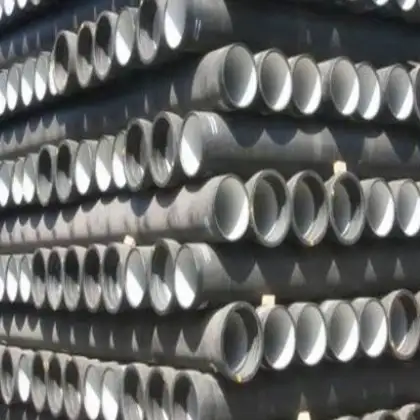With the development and progress of modern society, many everyday items in people’s lives are gradually being replaced by new materials. Take PVC pipes, for example—though still commonly used today, they are increasingly being substituted by ductile iron pipes in large-scale projects. Why choose ductile iron pipes? In this article, I’ll detail the reasons behind this shift.
1. Materials and Manufacturing Processes
I begin by examining how ductile iron and C900 PVC are made. Ductile iron pipe is produced by adding magnesium to molten iron, creating spherical graphite nodules that impart remarkable toughness. The molten metal is centrifugally cast in precision molds, then lined internally with cement mortar or epoxy. In contrast, C900 PVC is extruded from polyvinyl chloride resin, plasticizers, and stabilizers, then reamed and tested.
The state-of-the-art centrifuge casting ensures wall uniformity and eliminates defects. By contrast, PVC extrusion relies on maintaining exact melt temperatures and draw speeds—parameters that, if off, can lead to stress points or microvoids.
2. Mechanical Properties and Pressure Ratings
Ductile iron pipes boast tensile strengths up to 60,000 psi, whereas C900 PVC typically reaches around 7,000 psi [1]. Moreover, ductile iron’s pressure classes range from 150 psi to 350 psi, suited for municipal and industrial water mains. C900 PVC is rated up to 305 psi at 73 °F but loses capacity with temperature increases.
-
Tensile Strength: DI: 60,000 psi vs. PVC: 7,000 psi.
-
Pressure Rating: DI: up to 350 psi vs. PVC: up to 305 psi (drops by 50 psi at 140 °F).
These figures illustrate why ductile iron remains the go-to solution for heavy-duty, high-pressure service.
3. Longevity and Life-Cycle Costs
Here’s where ductile iron truly shines. With proper lining and cathodic protection, ductile iron pipes easily exceed 100 years of service life—twice that of PVC mains [2]. Although PVC’s upfront cost may be 10–20 % lower, when factoring in maintenance, repair, and premature replacements, ductile iron’s total life-cycle cost is up to 25 % less over a century.
“In a 50-mile pipeline network, replacing PVC every 50 years (its average life) versus a single ductile iron installation yields savings of $1.2 million in repairs and downtime.” – Municipal Water Journal.
4. Hydraulic Performance and Flow Capacity
I’ve often been asked: does PVC’s smoother interior give it an edge? Initially, yes—PVC has a Hazen-Williams “C” factor of 150, while cement-lined ductile iron pipes have C = 120. Yet, as ductile iron’s lining cures, its effective roughness improves, and over decades the PVC’s surface can age and deposit biofilm. Consequently, long-term head losses in PVC may exceed those in iron.

5. Corrosion Resistance and Protection Methods
It’s a common myth that iron must rust. In reality, ductile iron pipes use cement-mortar lining and external polyethylene wrap or cathodic protection to virtually eliminate corrosion. The lining creates a physical barrier, while cathodic protection maintains the pipe’s electrochemical stability. PVC, though inherently corrosion-proof, can be susceptible to UV degradation if stored improperly, plus potential leaching of additives into potable water—a growing concern in some municipalities.
6. Installation Practices and Jointing Systems
Ductile iron employs push-on, mechanical, or flanged joints that can accommodate deflections of up to 3° per joint, crucial in seismic zones. C900 PVC uses rubber-ring gasket joints that allow 1°–1.5° deflection. Mechanical restraint systems for PVC exist but add complexity. Additionally, DI’s heavier weight often reduces floatation issues in high groundwater, whereas PVC requires extensive bedding.
7. Environmental Impact and Sustainability
Assessing cradle-to-grave footprints, ductile iron scores well: it is 100 % recyclable, and scrap DI can be fed back into blast furnaces. PVC manufacture involves chlorine chemistry and generates dioxins if incinerated. When factoring in durability and fewer replacements, ductile iron’s overall carbon footprint for a 50 mile network is up to 40 % lower than PVC alternatives.
8. Case Study: Municipal Water Main Upgrade
City of Riverside, CA (2020–2023)
Facing frequent main breaks in aging PVC mains, Riverside replaced 15 miles of C900 PVC (8 in. diameter) with ductile iron pipe (AWWA C151, cement-lined). Over three years:
-
Break rate fell from 4 per year to 0.3 per year.
-
Water loss decreased by 22 %.
-
Customer complaints dropped by 85 %.
This real-world outcome underscores ductile iron’s reliability under dynamic loads and fluctuating pressures.
9. Comparison Table: Ductile Iron vs. C900 PVC
| Attribute | Ductile Iron (AWWA C151) | C900 PVC (AWWA C900) |
|---|---|---|
| Tensile Strength | ~60,000 psi | ~7,000 psi |
| Standard Pressure Rating | 150–350 psi | 150–305 psi (degrades at >73 °F) |
| Service Life | ≥ 100 years | ~ 50 years |
| Hydraulic “C” Factor | 120 (improves with lining) | 150 (may decline over time) |
| Corrosion Resistance | Cement lining + cathodic protection | Intrinsically corrosion-proof |
| Joint Deflection | Up to 3° per joint | 1°–1.5° per joint |
| Installation Weight | Heavy (requires cranes) | Light (easier handling, needs anchoring) |
| Environmental Footprint | 100 % recyclable, lower life-cycle CO₂ | Energy-intensive production, limited recycling |
| Cost (installed, per foot) | $40–$60 | $30–$50 |
1. Can ductile iron pipe handle earthquake-induced ground movement?
Yes. Its flexible joint systems allow greater deflection than PVC, maintaining integrity under seismic loads.
2. How does temperature affect PVC pressure ratings?
PVC’s pressure rating drops roughly 10 % for every 10 °F above 73 °F, whereas ductile iron remains stable up to 140 °F.
3. Is ductile iron more expensive than PVC?
Upfront, yes—by about 15 %. However, lower maintenance and longer life result in up to 25 % lower life-cycle costs.
4. What lining options exist for ductile iron?
Commonly cement-mortar per ANSI/AWWA C104, or epoxy coatings per ANSI/AWWA C116 for aggressive water chemistries.
5. Does PVC leach chemicals into drinking water?
Some studies note trace leaching of plasticizers, prompting utilities to prefer inert-lined DI for potable systems.
